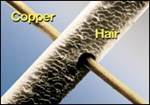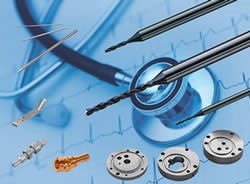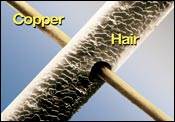Micro Tooling for a Growing Micro Moldmaking Market
Without proper tooling, one cannot imagine the challenges of entering a world of micro machining where the tooling used is sometimes also very challenging to see.
Today there is a very fast-growing need for micro machining tooling capabilities and it cannot be taken lightly. This is because new methods of medical and dental treatments continuously require new miniature components. These, in many cases, result in much less invasive procedures, enabling patients to recover more easily. High-speed communications advancements also are coming at rapid fire pace by using smaller componentry for less resistance in transmission of signals, sounds, etc. Many of these components also require mating molded parts, which also are extremely small. These molded components require smaller tooling than normal.
Where many drill and mill companies offer standard tooling from ¼: to 1" or 1¼" diameters, others offer from 6mm (.236" dia.) down to 0.1mm (.0039”dia) high-tech tooling of solid and coolant through carbides. Tools can also be made available down to .01mm (.00039") diameters. At this point, you are at the 10 micron level. Considering that a human hair is 60 microns or .0024" diameter, machining practices become very exact.
With the challenge of overseas competition continually bearing down on North American manufacturers, moldmakers need to provide solutions, tools, and most importantly, availability. Problem solving and proper tooling with availability is key. In short, how moldmakers service the micro moldmaking market is extremely critical.
Presently, a moldmaker has the benefit of being able to machine his components in the semi hard or hardened states, which means that he also can eliminate polishing by using proper tooling—thus not needing to handle the part many times. This is done by selecting the proper starting, finishing and super finishing mills that are available in the above mentioned sizes. Hard drilling also is possible in many cases.
In the past, the components would be finished as best as possible with machining methods, such as tracer mills and/or multi operation-type NC/CNC operations, then polished, heat treated and sent to a plater. These processes could involve weeks or months of handling prior to assembly, testing and shipping.
With the advent of multi-axis machinery and the high-tech tools of which we speak, this has changed. We now have the option of finishing intricate forms in the heat-treated state to a polished finish, then plating, assembling, testing and shipping or using the mold in production. This is how the moldmaker can provide better service to his customer, but the tooling needs to be available to him.
When choosing the tooling, quality, repeatability and availability are the three most important criteria. Purchasing in this manner will be key to producing the results needed for a cost-efficient process. If one shops only for price, there is a great possibility of scrap, delivery delays, etc.
Micro Tooling Selection
When the proper micro tool is chosen for moldmaking, there are many parameters with which to deal. The most important is knowing exactly what materials are being machined and their hardness or toughness qualities, or “machinability”. Guessing or coming close on this point will lead to much wasted time and tooling.
The next parameter to consider should be the efficiency of the spindle (e.g. size and construction for rigidity, effective temperature control and accuracy). These spindles will generally be run at very high rpms compared to regular CNC machining processes, depending on the hardness of material and results needed. Proper machinery may be discussed with the tooling manufacturer, and many are available to the moldmaker.
If coolants are being used with coolant-through tooling, then viscosity, filtration, lubricity, cleanliness of sump and psi will all become additional factors with small tooling. Criticality is increased greatly.
To deal with these parameters, it is suggested that the moldmaker consult with the providers of the lubricants and apparatus involved. Suggestions also may be made by the tooling company during the purchasing process.
Between the spindle and the tool you need to consider the toolholding capacity. Here it is recommended that drills are held and run—depending on diameter—to within .0002" t.i.r. max. This will ensure better tool life, tolerances, hole shape, etc. As the tooling gets smaller, the tolerance becomes tighter.
For extremely small drills, the tolerances should be held as close to “0” as possible. Yes, we are striving for perfection. This is the insurance needed to effect a successful end result.
Accurate toolholding may be accomplished with ultra precision collets or with hydraulic holders or shrink fit holders. All provide very close tolerancing when chosen carefully and used properly. Setups should always be verified prior to use. This is done by the use of good tool pre-setters. These can also be discussed with the tooling provider when purchasing the tools.
Some solid carbide drills are available from stock in 0.4mm (.0016") to 6mm .236") diameter sizes, in increments of .05mm (.002"). A line of solids from .1mm (.004") to 2mm (.078") diameter in increments of .01mm (.0004") then from 2mm (.078") to 3mm (.118"), in increments of .05mm (.002") are also available.
Coolant through carbide drills are available from .0.75mm (.0295") diameters to 6.0mm (.236") diameters with increments of .05mm (.002"). They are all available in 6, 10 and 15 x dia. depth capabilities from stock.
Applications
Examples of drilling hardened mold and die steels with and without coolant through are as follows:
| Material: 02 die steel; |
Material: h13 mold steel |
| Hardness Range: 55 to 65 r/c | Hardness Range: 45 to 55 r/c |
| Diameter: 1.8mm | Diameter: 1.40 mm |
| Depth: 4 x dia. | Depth: 4 x diameter |
| Drill: cd.040180.s (solid carbide) | Drill: cd.070140.s (solid carbide) |
| Speed and Feed: 90 sfm and .0008"/rev. | Speed and Feed: 115 sfm and .0004"/rev. |
| Material: 02 die steel; | Material: h13 mold steel |
| Hardness Range: 55 to 65 r/c | Hardness Range: 45 to 55 r/c |
| Diameter: 1.8 mm | Diameter: 1.45 mm |
| Depth: 6 x dia. | Depth: 15 x diameter |
| Drill: cd060180.cs (coolant through carbide) | Drill: cd.150145.cs (coolant through carbide) |
| Speed and Feed: 125 sfm and .0006"/rev. | Speed and Feed: 115 sfm and .0008"/rev |
When looking for drills, one must exercise caution. Again, quality, repeatability and availability are the keys. Inexpensive drills that will not produce consistently toleranced holes will not help. Drills offered, but not available also are useless. Finally, look for drills that set themselves apart time after time by performing. Many drill companies try to sell drills that “run” faster. Higher rpms with drills at this level, if not fed properly, will actually cook the drill. Choose drills that can be run at required speeds recommended, but with better feedrates, which allow a savings in hole production times, resulting in more time left over to do other jobs—becoming more efficient.
These results were attained using care in setup with consideration to spindle, coolant, toolholding and workholding.
Micro end mills are also provided for this industry that are available in a range from 0.1mm (.004") to 6.0mm for small diameter requirements and also provided up to 12mm from stock. The mills are provided in square, ball and corner radius-type forms.
The mills are made of super micro grain structure with coatings and excellent ground finishes, with high tolerance levels, which insures performance, tool life and results needed for the very economic production of molds.
Mills also are provided for micro and small diameter milling in CBN tip styles for super finishing of mold components. When surface finish results from solid carbide aren’t quite enough for extremely demanding finish work, CBN tooling is recommended. These are used in material hardnesses from 40 r/c to 70 r/c.
When plunge milling in mid-range hardness steels, a patented plunge mill should be considered. The mill allows one cutter, with no ramping or predrilling operations to plunge and rough the slot and also to finish it. This is a great timesaver, keeping the moldmaker more efficient.
With end mills, the best selection is made by choosing a product that sets itself apart. A consistent rpm level can be selected with a higher feedrate, only if the tool can consistently perform. In many cases, the proper tool will even last longer while effecting a shorter cycle time. This saves machine time and makes the moldmaker and his process more efficient.
Examples of milling results for mold components are as follows:
| Material: 420 st.mold steel |
Material: s7 |
| Hardness: 50/52 r/c | Hardness: 52/55 r/c |
| End Mill: solid carbide 2 flute ball | End Mill: solid carbide 2 flute 30° spiral |
| Process: contour finish mold milling | Process: mill contours to finish |
| Result: exceeded existing leading competitor’s tool life by 40 to 50 percent and enhanced finish product conditions. | Result: doubled tool life of leading competitor and reduced cycle time. |
Summary
Today in the medical, dental, high-speed communication, aerospace, micro-controls, and other fields, many components are machined, molded or both. These are presently sectors of our industry that are not on the decline, but instead, are constantly growing. These are key markets on which to focus, especially in these economic times.
![]()
Related Content
Developments in High-Speed Machining Technology
There have been many exciting developments in high-speed machining relative to machining centers and controls, tooling and CAD/CAM systems.
Read MoreMoldmakers Deserve a Total Production Solution
Stability, spindle speed and software are essential consideration for your moldmaking machine tool.
Read MoreSolving Mold Alignment Problems with the Right Alignment Lock
Correct alignment lock selection can reduce maintenance costs and molding downtime, as well as increase part quality over the mold’s entire life.
Read MoreThe Benefits of Hand Scraping
Accuracy and flatness are two benefits of hand scraping that help improve machine loop stiffness, workpiece surface finish and component geometry.
Read MoreRead Next
Re-defining Precision
It’s important not to limit the definition of precision to one in particular, but instead expand the definition to three unique precision types: micro precision, ultra precision and nano precision.
Read MoreReasons to Use Fiber Lasers for Mold Cleaning
Fiber lasers offer a simplicity, speed, control and portability, minimizing mold cleaning risks.
Read MoreHow to Use Strategic Planning Tools, Data to Manage the Human Side of Business
Q&A with Marion Wells, MMT EAB member and founder of Human Asset Management.
Read More
























